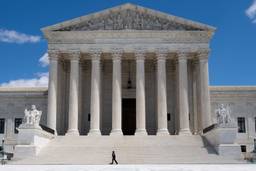
On July 1, the day after the Supreme Court issued its controversial decisions in Harris v. Quinn and Burwell v. Hobby Lobby, it issued a round of “miscellaneous orders” to wrap up loose ends before the Court went into recess. In the first of a long list was a GVR (grant, vacate, remand) order voiding the 6th Circuit’s decision in another case that had been appealed to the Court, and sending it back to the lower court “for further consideration in light of Harris v. Quinn.” In Harris, the Supreme Court held that the First Amendment did not permit a fair share or agency fee provision requiring objecting home healthcare workers to pay a fee to the union for collective bargaining and contract administration.
The case at issue is Schlaud v. Snyder, out of Michigan, and in many ways it looks like Harris. Just as in Harris, the plaintiffs — also represented by the right-wing National Right to Work Legal Defense Foundation (NRTW) — are a few homecare providers suing the union, the governor, and the state Department of Human Services for the return of union dues on First Amendment grounds.
Up to a point, the case was strikingly similar to Harris v. Quinn. In the fall of 2006, there were more than 40,000 homecare workers in Michigan eligible for the bargaining unit, and 22,180 signed authorization cards in favor of union representation. This triggered a secret-ballot election, in which 5,921 of 6,396 participating workers voted in favor of the union — 92.5 percent of the ballots cast. The union then negotiated a collective bargaining agreement with management, which included a standard “agency fee provision”: All workers covered by the agreement — even those who didn’t vote for the union — would have to pay a fee of approximately 1 percent to offset collective bargaining and contract administration costs. The rationale for such provisions is that the union must represent all workers covered by the collective bargaining agreement, and all workers — whether they object to the union or not — benefit from this representation.
The agreement was overwhelmingly ratified by union membership, by a vote of 4,806 to 78, according to an independent arbitrator.
Then, in early 2010, the plaintiffs filed a class action, arguing that the payment of any dues was a violation of their First Amendment rights of free speech and association.
Here’s where the facts of the case significantly deviated from Harris. In any class action, the plaintiffs must be granted class certification by the court, where, among other things, it must show that “the representative parties will fairly and adequately protect the interests of the class.” In Harris, the issue never turned on the adequacy of the class because SEIU and the governor filed a motion to dismiss, which the lower court granted. However, in Schlaud, NRTW argued that the class should include every Michigan homecare worker who had any dues or fees deducted from their paycheck, and this issue became a point of dispute. In essence, the five named plaintiffs claimed that they represented more than 40,000 workers, the majority of whom had signed union authorization cards.
The District Court saw this enormous absurdity of trying to say that five objecting members represented the interests of a class of 40,000 workers, and denied this class definition. So NRTW tried again, trying a narrower definition of the class, but still one broader than simply the few workers who did not want to pay any fees to the union. On its second attempt, NRTW argued that the class included all Michigan homecare workers who have had dues deducted and did not sign authorization cards or vote for the union. In effect, NRTW was arguing that anyone who didn’t participate was de facto voting against the union. If one applied this same standard to presidential elections, where non-participation is counted as being against the person running, it’s unclear if any president in U.S. history could have been declared legitimate.
Predictably, the court saw through this and rejected the proposed class, stating that it “cannot simply assume that non-voting providers are hostile to union representation.” Upon appeal, the 6th Circuit affirmed the District Court’s decision. So NRTW appealed the decision to the Supreme Court, where it sat while Harris was considered.
It’s hard to know the Supreme Court’s motivation in vacating and remanding Schlaud, but it may be a quiet expansion of the Harris decision. If the Supreme Court is sending a signal to the lower court that Harris requires that it reverse itself on the class certification issue, then it is indicating an agreement with one of NRTW’s problematic arguments: that the baseline for union agreement should be reversed so that it is assumed that workers object to the union unless they continually affirm their support. If the NRTW’s argument is taken to its logical extreme, workers who vote for the union and for the contract could still be considered union objectors.
The Supreme Court’s GVR order cannot necessarily be read as agreeing with NRTW’s argument, but it is likely to cause such confusion. Erwin Chemerinsky and Ned Miltenberg — who have both argued cases many times before the Supreme Court — have written that the Supreme Court issues such orders “rather reflexively, even when its underlying decisions on the merits of one case provides scant reason for revising a lower court’s ruling in a different case.” However, they argue that such orders often lead lower courts to reverse their decisions for fear that the Supreme Court will overrule them. If that is the ultimate result in Schlaud, then Harris will provide anti-union groups yet another tool to attack labor.
GVR orders and what the Supreme Court does after releasing its last decision of the term may seem to be the stuff of technical civil procedure, far removed from the merits of any ultimate labor cases. But, as my old civil procedure professor used to say, “learn your CivPro; it’s how cases are won and lost.”
Moshe Z. Marvit is an attorney and fellow with The Century Foundation and the co-author (with Richard Kahlenberg) of the book Why Labor Organizing Should be a Civil Right.








